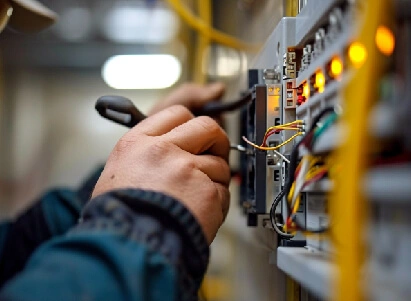Managing ship maintenance is crucial for maximizing uptime, ensuring safety, and reducing costs throughout a vessel’s lifetime. A strong preventive maintenance system is key, whether you manage one ship or a fleet of 1,000. Here are some effective strategies for implementing a comprehensive ship maintenance plan.
1. Schedule Routine Preventive Maintenance
A well-planned maintenance schedule is the foundation of successful ship maintenance. Follow manufacturer recommendations, consider operating conditions, and adhere to regulatory requirements. Prioritize preventive maintenance to avoid major malfunctions and costly repairs. Keep thorough records of all maintenance tasks, inspections, and repairs for future reference and trend analysis.
Safety is a top priority both on and offshore. To comply with the International Safety Management (ISM) Code, vessels must have a preventive maintenance system. This system not only ensures compliance but also guarantees the safety of your crew and assets.
2. Improve Your Inspection Process
Effective ship maintenance management requires thorough pre- and post-trip inspections to identify and address issues promptly. Employing an electronic inspection system can streamline this process. Customizable electronic inspection forms allow for quick assessments, photo uploads, and immediate issue resolution, even while the vessel is still at sea. This accelerates planning and execution of necessary repairs upon return to port.
Regular inspections are vital to identify any signs of wear, damage, or malfunction that require immediate attention. Key areas to inspect include:
– Leaks and Cracks: Check for any signs of leaks or cracks in the hull and internal compartments.
– Safety Equipment: Ensure all safety equipment, such as lifeboats, life vests, and fire extinguishers, are in good condition.
– Navigation Systems: Regularly inspect navigation systems for accuracy and functionality.
Keeping the ship clean is essential to prevent the buildup of dirt and marine organisms. Regular cleaning includes:
– Exterior Cleaning: Remove marine growth and other debris from the hull to reduce drag and improve fuel efficiency.
– Interior Cleaning: Maintain a clean environment inside the ship to ensure the health and safety of the crew.
3. Regularly Clean the Hull
The hull is constantly exposed to seawater, which can cause corrosion and structural damage. Maintaining a clean hull is vital for a ship’s performance and durability. A clean hull reduces drag, improves fuel efficiency, prevents corrosion, and minimizes marine growth. Hull cleaning can be done through mechanical methods, chemical cleaning, or advanced technologies like Remote Operated Vehicles (ROVs) and underwater drones. The frequency of cleaning depends on water type, voyage length, marine growth, and regional regulations. Apply and maintain protective coatings to prevent corrosion and preserve the ship’s structural integrity. Inspection: Regularly inspect the hull for signs of corrosion or damage and perform necessary repairs.
4. Inspect and Maintain Anodes
Anodes protect the hull and other components from corrosion. Regular inspection and maintenance are crucial. Dry-docked anodes should be inspected every two to three years, while continuously submerged anodes require more frequent checks. Over-corroded or significantly reduced anodes should be replaced, and any marine growth should be removed to maintain effectiveness.
5. Lubrication and Fluid Checks
Proper lubrication and fluid maintenance are critical for preventing friction and wear in various ship components. A regular lubrication schedule is essential to prevent friction and wear on the ship’s many moving parts, such as the main engine, steering gear, and deck equipment. Identify all lubrication points, choose appropriate lubricants, and schedule lubrication tasks at suitable intervals to extend machinery life, improve efficiency, and reduce the risk of costly repairs. Check and replenish fluids, such as engine oil, coolant, and hydraulic fluids, to ensure optimal performance and prevent overheating or component failure.
6. Inspect and Maintain Electrical Systems
The electrical system powers various onboard equipment and systems. Regular inspections and maintenance of electrical systems are vital for ship safety and functionality. Conduct quarterly or monthly visual inspections, focusing on critical components like batteries, terminals, wiring insulation, and switchboards. Use high-quality multimeters for testing and consider thermal imaging cameras to detect potential overheating issues before they cause damage.
Inspection: Regularly inspect wiring, connectors, and switches for signs of wear or damage.
Testing: Perform tests to ensure electrical components are functioning correctly and to prevent malfunctions, shorts, or fires.
7. Maintain Marine Cutlass Bearings
Marine cutlass bearings are crucial for the ship’s propulsion system. They support the propeller shaft and allow it to rotate freely while maintaining alignment. These bearings are typically made from non-metallic materials like rubber or synthetic polymers to reduce friction and absorb vibrations. Proper maintenance of marine cutlass bearings involves:
Regular Inspections: Check for signs of wear, such as excessive clearance or damage to the bearing material.
Replacement: Replace worn-out bearings to prevent shaft misalignment and potential damage to the propeller or surrounding components.
Lubrication: Ensure proper lubrication to reduce friction and wear.
8. Engines and Propulsion Systems
The ship’s engines and propulsion systems are critical for its operation. Regular maintenance tasks include:
Oil Changes: Regularly change engine oil to maintain performance and prevent engine wear.
Filter Replacements: Replace filters to ensure clean fuel and air supply to the engine.
Leak Inspections: Check for and repair any leaks to prevent engine damage.
Navigation and Communication Systems
Accurate navigation and effective communication are vital for safe voyages. Maintenance tasks include:
9. Calibration:
Regularly calibrate navigation instruments to ensure accurate readings. Perform routine checks on communication systems to ensure they comply with international regulations and function properly.
Conclusion
Implementing a robust ship maintenance plan involves protecting your assets, scheduling routine preventive maintenance, improving inspection processes, optimizing inventory management, regular cleaning, anode maintenance, lubrication of moving parts, electrical and mechanical system inspections. A well-maintained vessel ensures safety, operational efficiency, and cost-effectiveness, ultimately leading to a profitable and reliable fleet.


